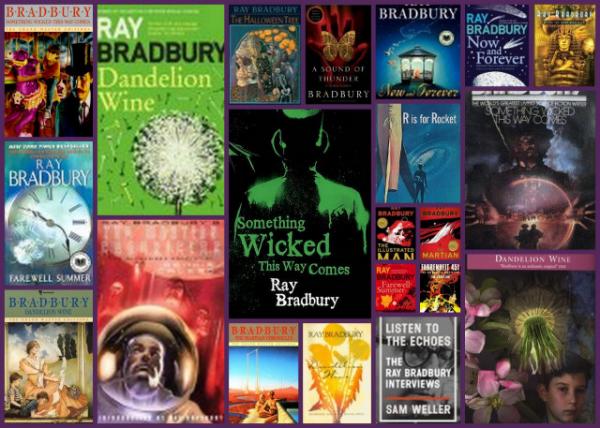2017-09-19
【Aiden in English】
Ray Bradbury, an iconic American author, has written many stories. Each book and story has a different plot, setting, and characters. However, unlike other authors, Bradbury uses broad, general themes that stretch throughout many stories. The Illustrative Man, a book comprising multiple shorter stories, shares similar themes with another short story, “There Will Come Soft Rains.” These stories all share a common theme: a negative, pessimistic vision of the future. In a desolate place ravaged by nuclear weapons, a house struggles to maintain its condition, awaiting an owner who will never return. “There Will Come Soft Rains” is about a futuristic world of death. This short story takes place before an imminent nuclear war, and the ensuing blind panic of people running for survival shares a pessimistic view with another story, “The Highway.” Both show a gloomy vision of the future’s weapons, describing their effects on humanity. The lack of humans in “There Will Come Soft Rains” somewhat hints at the dominance technology implements, a theme further emphasized throughout the story by machines completing everyday human tasks. Similarly, the preeminence of technology is also evident in “The Highway,” as demonstrated by the driver who speaks about “the end of the world” (Bradbury). In both, weapons reach a point of destroying the Earth, a theme Bradbury commonly explores in these stories. “Kaleidoscope” brings about another pessimistic vision of the future. A short story from The Illustrated Man, “Kaleidoscope,” matches up very well with “There Will Come Soft Rains.” A group of stranded astronauts in space, “Kaleidoscope,” beautifully depicts the moments leading up to their demise. Their conversations formulate a plot that dives deep into what drives humans to live and what holds them back. “Kaleidoscope” shares a similar pessimistic vision to “There Will Come Soft Rains.” Giving a sense of sheer hopelessness, the astronauts represent humanity on a new scale. “Space, thousands of miles of space, and these voices vibrating at the center of it.” (31). Ironically, it is the technology that has allowed humans to achieve space travel, and yet, in its most crucial moments, it lets humanity down. This form of dependency and hopelessness is exhibited in both stories, as seen in the technology struggling to maintain the house’s condition in “There Will Come Soft Rains.” Surpassing the limit of human survival, the technology showed its close yet distant ties with humanity. While the failure of “Kaleidoscope” technology contrasts with the house’s superior technology, both demonstrate an inseparable bond that binds humans to technology for survival. Finally, Bradbury attacks this weakness of humans, stripping away the help of technology in both stories, and shines the harsh truth that humans are nothing without their creations. 【紅霞譯】
雷·布萊伯利是一位影響美國文化的作家,畢生寫過大量著作,每部作品在表現手法、背景結構以及人物性格上都保持獨特風格。與別的作家不同,布萊伯利將廣博的主題思想貫穿於許多創作之中,其短篇故事集《圖案人》與小說《細雨將至》共同擁有這樣一個特點:對未來消極悲觀。
在慘遭核武器摧殘之後的荒郊野外,有棟厄舍岌岌可危,差點連影子都看不到了,《細雨將至》向讀者娓娓道來這個終將滅亡的世界。故事發生在核戰爆發之前,茫然無措的人們為了生存四處奔波,與《高速公路》表現的悲觀情緒毫無二致。兩部小說對未來武器悲觀失望,闡明核戰對人間世情的影響。《細雨將至》或多或少暗指人類消亡與現代科技有關,進而引申自動化機器打破常規完成人類使命。精湛的智能科技同樣再現《高速公路》一書,難怪熟諳車技的司機稱之為“世界末日”(布萊伯利)。兩部小說中,武器水平均已達到終結地球的地步,這正是布萊伯利慣於談論的話題。 《萬花筒》是另一部對未來充滿悲情的作品。繼《圖案人》之後,與《細雨將至》題材相仿的短篇小說《萬花筒》出爐,它巧妙地描述了一群滯留太空的宇航員臨終前喜怒哀樂,故事從他們之間的對話着手,深入探討促進人類進步的動力和阻撓人類發展的障礙,身處絕境的宇航員把人道主義提升到一個嶄新的高度。“太空,方圓數千里的太空,這些發自肺腑的心聲迴蕩在宇宙之中。”(第31頁)值得回味的是,科技既能幫助人類太空旅行,也會在緊要關頭讓人類喪失信心。兩部小說先後展示人類對科技的依賴和絕望,如同《細雨將至》中科技已無力挽救搖搖欲墜的住宅,一旦超越地球承受極限,科技與人類雖近猶遠。儘管《萬花筒》有別於《細雨將至》演繹的科技失敗,但彼此之間有一種不可分割的紐帶將人類與科技聯繫起來,以此求得生存。最後,布萊伯利抨擊這些人性弱點,兩個故事如若排除科技相助,殘酷現實便擺到面前:離開科技創新,人類一事無成。 Today in History(歷史上的今天): 2012: Bio Poem(四年級自傳體詩歌) 
Crosslinks(相關博文): 6th Grade Context Analysis─Eulogy to Freak(初一語境分析─悼念弗里克) 6th Grade Text-dep Analysis─Stone Age Discovery(初一語境分析─石器時代創新) 5th Grade Text-dependent Analysis—Lab Rats(五年級語境分析—《超能高校生》) 9th Grade(高中一年級) |
